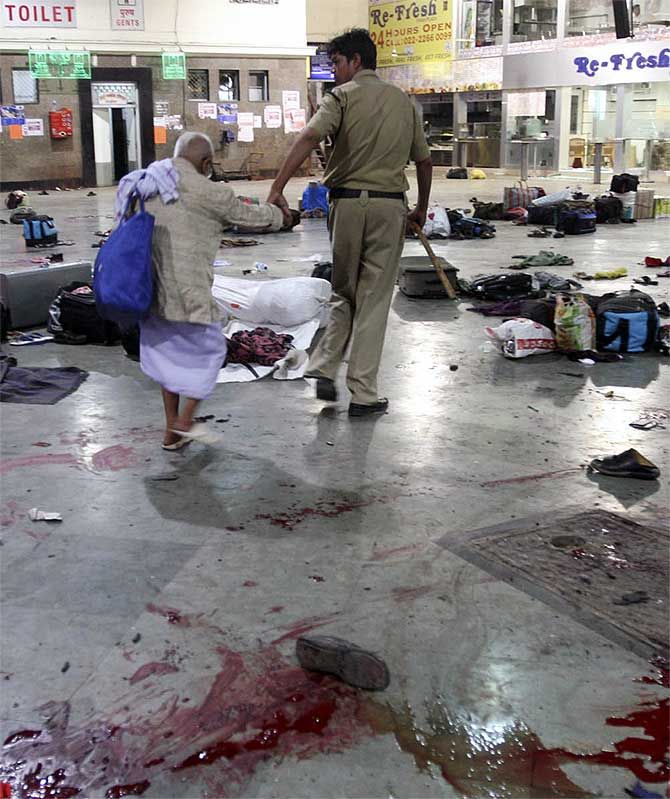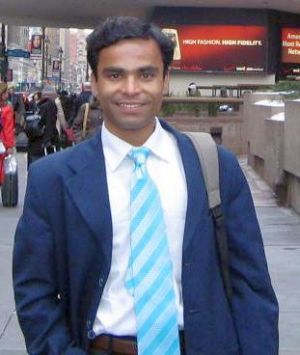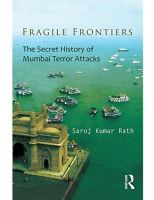 | « Back to article | Print this article |
'There were three locals who helped in carrying out the attacks. Headley was supported by an Indian named Basheer, who incidentally is also a friend of Rana and arranged the travel documents for Headley.
'When Headley landed in India, he was received by Basheer. But the police never probed Basheer and he continues to remain a mystery to all security agencies. Sabahuddin Ahmed and Fahim Ansari too played a role in carrying out the attacks.'
Saroj Kumar Rath, author of the newly-published book Fragile Frontiers: The Secret History of Mumbai Terror Attacks, speaks to Rediff.com's Vicky Nanjappa.
(We republish this feature as we mark the 10th anniversary of the 26/11 attacks. This feature was first published in 2014)

The world saw Bombay under siege for over 48 hours by 10 Lashkar-e-Tayiba terrorists in November 2008. The 26/11 terror attacks, which claimed over 160 lives, will be something that India and the rest of the world will never come to terms with.
Fragile Frontiers: The Secret History of Mumbai Terror Attacks is probably one of the most well-written books which explores every bit of the attack, prior to it and after it. Written by Saroj Kumar Rath, an assistant professor of history at the Sri Aurobindo College (Evening), University of Delhi, the book provides facts about the attack and, more importantly, how shoddy the probe was.
In an interview to Vicky Nanjappa, Rath, left, below, speaks about a mysterious Basheer who received David Headley in India before he went about surveying the targets that were attacked. Rath says the entire attack was planned and executed in a bid to keep the militants in Pakistan, especially the Lashkar, united.
Please tell us something about your book.
The book deals with the 26/11 attacks and also points out that it was not an isolated incident. After going through several documents related to the incident, I have been able to trace why the attack took place. There have been many attacks in India, but there has not been much study on it.
I have taken into account what was at stake in this attack. After going through 12,000 pages of the charge-sheet and other documents I found it strange that there is no scrutiny on the Lashkar.
The book also deals with how the attack was planned and the conspiracy angle. During my research I realised that after the September 11, 2001, terror attack in the United States of America, the people there got a sense of what happened during that attack. In India, post 26/11, most of the details were kept a secret and the public does not know a lot about the attack.
 What in your view was the motive behind the attack?
What in your view was the motive behind the attack?
The US tightened its security post 9/11. In 2003, (former Pakistan President) General Pervez Musharraf executed nearly 3,000 arrests. Although Pakistan claimed to be providing the US support, they were still backing militants. There were a lot of militants in Pakistan who wanted to fight against the US in Afghanistan, which Pakistan did not approve of. The 26/11 attack was planned to stop this and to keep the militants in Pakistan united.
Please tell us more…
The attack was not planned overnight. Pakistan wanted it to be a spectacular attack. The Pakistani army, which was fighting in Afghanistan, was in a dilemma whether to fight the battle with the US or fight against their own brothers. It was during this time that around 1,700 Pakistani officers deserted their army. They either joined the militants or decided to stay home. There was a lot of disillusionment in the Pakistani army and also among the militants. Pakistan wanted to lift the morale of these people. It was then that they decided to orchestrate such an attack. The Lashkar was in the meantime debating whether to go and fight the war in Afghanistan or not. Pakistan, however, wanted to desperately keep the Lashkar away from Afghanistan. They wanted to keep them busy and that is how the Mumbai attacks happened.
Let us speak about (the Pakistani-American Lashkar operative) David Headley...
David Headley was an extremely useful person. In 1989 he was sent by the US to Afghanistan to collect information on drug lords. There is enough material to prove that the US knew about Headley. After the Mumbai attacks his girlfriend informed the US about him. He was planted by the US into the Lashkar. But post 26/11, he was not given any job although he wanted to continue fighting and even Pakistan was aware of this. Pakistan’s intelligence agency, the ISI, had decided to use him as an asset but that plan was changed later.
What about India? Did we have information on him?
India is not that proactive. India had no information about him. The US knew about this attack. Headley was arrested nearly a year after the 26/11 attack. He was arrested for his role in the Denmark Mickey Mouse project case. It is interesting that the US wanted to keep him quiet after the 26/11 attack since he was proving to be dangerous. They felt he would try and blow up the Empire State Building. The US came to this conclusion since Headley’s friend (and accomplice) Tawwahur Rana had his office in the Empire State Building, and the former was an unofficial entrant in his office. The US felt that since he knew a lot about the building, his next plan would be to replicate a 9/11 kind of attack on the Empire State Building.
During the course of your study did you find if there was any local support during the 26/11 attacks?
There were three locals who helped in carrying out the attacks. Headley was supported by an Indian named Basheer, who incidentally is also a friend of Rana and arranged the travel documents for Headley.
When Headley landed in India, he was received by Basheer. But the police never probed Basheer and he continues to remain a mystery to all security agencies. Sabahuddin Ahmed and Fahim Ansari too played a role in carrying out the attacks.
Both had Pakistani passports and had provided the attackers with handmade maps. The police found these maps in (terrorist Ajmal Kasab’s accomplice)Ismail Khan’s pocket.
Kasab had confessed before a magistrate that two Indians had provided them handmade maps. However, the investigators were not able to relate these incidents and prove it in court.
But if there was no map, how did the Rampur police probing the 2008 CRPF attack case in which Fahim and Saba are accused, have the same map with them?
They were arrested much before the 26/11 attack case by the Rampur police and they had found the same map on them. A weak and shoddy probe by the police led to their release.
The other local, Abu Jundal’s role in the attack is very clear.
 Are you aware of a lady who guided the terrorists from Machimarnagar?
Are you aware of a lady who guided the terrorists from Machimarnagar?
There is not much information about this lady, but there is a claim that one lady had argued with one of the terrorists and she could have been the one who helped them.
Tell us more about the Indian investigation into the attack.
The charge-sheet is weak and poorly made. The prosecution took a very casual approach. The charge-sheet is all about forensics, loss of public life, post-mortem report and a confession by Kasab. It is a shoddily prepared charge-sheet.
Kasab was interrogated for eight hours by the FBI 20 days after the attack. They extracted whatever they wanted to. Now compare this with Headley. It took us nearly one year to get access to him. Moreover, when we questioned him no magistrate was allowed and there was no permission granted to videograph or record the conversation. The US did not let us do this as they feared they could stand exposed and India did nothing much about it.
How do you analyse the handling of the attack by our forces?
There was a total absence of leadership. The MARCOS (marine commandos) arrived at the attack site but refused to enter Taj Mahal Hotel saying they had no written order. The National Security Guard plane from Delhi was delayed. Had the local police been trained, they could have tackled the attack.
You accuse the investigators of not dealing with the Lashkar more in the chargesheet.
It is not as though there were no attempt being made to attack the US after 9/11. They have prevented 20 out of 22 attacks post 9/11. The vigilance of the US has ensured that attacks have not taken place on US soil.
After 26/11 the US sent a team to probe the case despite the Lashkar not attacking the US even once. On the other hand we have been repeatedly attacked by the Lashkar and there is no organised attempt being made to understand the outfit. How the Lashkar has been behaving post 26/11, their threats and plans, India has not tried to understand it.
What have you understood of the Lashkar post 26/11?
Hafiz Saeed (the Jama'at-ud-Da'wah leader) is a very powerful man. He himself had attended a meeting of the ISI and the army recently to plan and ignite a conflict across the border. This meeting was held a few days before our jawans were beheaded by Pakistan. The Lashkar had a huge network and today they have enough control over every wing. For money they have the Jama'at-ud-Dawa and for militancy the Lashkar.
They were not into politics all these years but having realised the need for a political voice to survive longer, they launched the Difa-e-Pakistan. They have realised that unless they have a pressure group within the political circle they cannot survive for long. They have integrated with the army, politics and society. They are now capable of carrying out an attack on a large scale compared to 26/11.
How difficult was it to research this book?
Not a single official document, like the charge-sheet, counter-affidavits, the confession statement of Kasab, interrogation report, dossiers to Pakistan, the Ram Pradhan Committee report, Headley’s interrogation report etc, is available in the public domain. My RTI queries were deliberately delayed or refuted by the Maharashtra government and the ministry of home affairs, Government of India. Officials were reluctant to speak on this issue.
I used to read various reports at various sources like Rediff.com, the Times of India, The Hindu, New York Times, Guardian or ProPublica where the journalists were frank in reporting split reportage about various classified documents. At this juncture, I started thinking the way a journalist thinks and started developing sources and source materials.
It was all frustrating to visit more than five courts, especially when the judiciary is not cooperative to researchers and analysts.
The first paragraph in the acknowledgement section in the book reads as follows: ‘Academic research on contemporary topics is often stymied by the inevitable gap between the researcher’s quest to settle the myriad number of questions and the daunting obstacles in assembling source materials. Such gaps, most of the time insurmountable, by less resourceful academics, strike a fatal blow to the quest of the researcher who swallows agony before withdrawing from such enterprising research’.
Because of the difficulty in gathering information, there is no academic scrutiny as well as genuine analysis till date on this issue. This book, the first such attempt, was commissioned under tremendous limitations and confined circumstances.
Was it easy to gather the information? Were the officers and government officials connected with the probe easy to speak with or were they being difficult?
Gathering information was frustrating, risky and troublesome. Not a single official or person involved with the case was forthcoming with cooperation. In fact, (one MoH official went to the extent of going to the Chief Information Commission to deny me mere facts and information, which are available on the web) many tried to scuttle the study.
Fahim Ansari’s counsel Advocate Shahid Azmi was killed during the trial (although his death was not related to Mumbai attacks). I had a long discussion with him. At one point of time, I was barred to attend the proceedings at Court No. 10 at the Patiala House Court, New Delhi, where Headley’s matter was being argued. My laptop, full of Mumbai attacks research material, was stolen (a criminal case, no. 65/4 of 2013 was filed at the metropolitan magistrate, Tees Hazari Court, Delhi) and I wondered if somebody was after me to derail the study.
But among all the difficulties, many journalists and faceless intelligence officials came forward to help me understand the case. Advocate Ujjwal Nikam was kind enough to meet me twice and explain the case. He was very much open to explain the case. I got only one chance to visit the Arthur Road jail where Kasab was closely guarded by the ITBP and Maharashtra police.
But the Maharashtra police had no time to discuss the case as my repeated requests to meet its officials were denied. The chief investigating officer in the case, whom I met briefly at the Arthur Road jail, was evasive in his response and refused to share any document or information. In Delhi, the ministry of home affairs is a no-go zone for researchers which functions behind extremely opaque walls.
The search for source materials was vast and expansive, covering six countries (India, Pakistan, the US, Italy, the UK, Australia thanks to Julian Assange’s WikiLeaks) in four continents (North America, Asia, Australia and Europe). It was anything but easy.